最新版PEP小学英语毕业总复习资料.doc
最新人教pep版小学英语毕业专项复习——第四部分 时态精析 第五节一般过去时
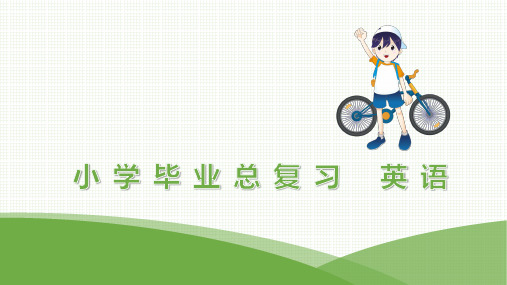
3. A: There was a great game on TV. ___D_i_d_y_o_u__w__a_tc_h__th_e__g_a_m__e?___________
B: No, I didn't. I was sick (生病的) and slept early. 4. A: __D_i_d__y_o_u_s_t_a_y_a_t_h_o_m__e_a_n__d_w__a_tc_h__T_V__y_e_s_te_r_d_a_y_?___ B: Yes, I stayed at home and watched TV yesterday.
返回目录
三、一般过去时的句型结构 1. 肯定句: (1)主语+was/were+其他。如: I was at home last night. 昨天晚上我在家。 (2)主语+动词的过去式+其他。如: They went to the park last weekend. 上个周末他们去了公园。
返回目录
返回目录
4. What ___d_id_____ you ____d_o_____ (do) the day before yesterday? 5. Last week, we ___p_ic_k_e_d___ (pick) many apples on the farm. 6. My mother __d_id__n_'t_d__o_ (not do) housework yesterday.
第二篇 专项提升
返回目录
第四部分
时态精析
第五节 一般过去时
知识梳理 一、一般过去时的用法 一般过去时表示在过去的某个时间内发生的动作或存在 的状态。 时间标志词:yesterday, yesterday+ morning/afternoon/evening, last+night/week/year, ago, before, the day before yesterday, just now等。如: I went to the supermarket yesterday. 昨天我去了超市。
PEP人教版小学六年级毕业班英语复习资料(三至六年级)
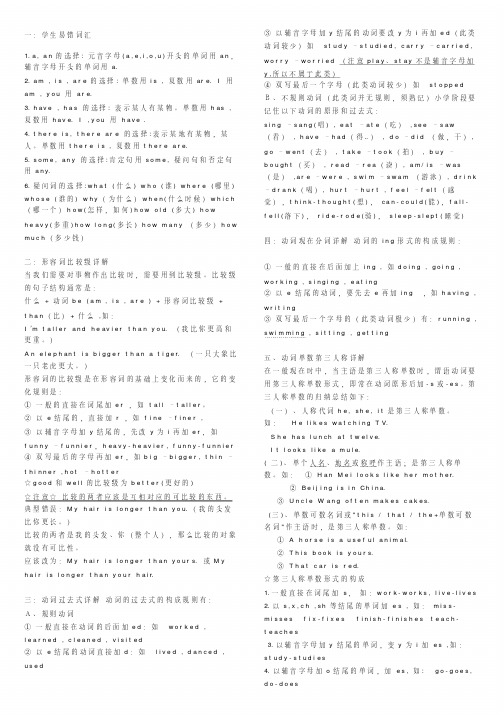
一:学生易错词汇1.a,a n的选择:元音字母(a,e,i,o,u)开头的单词用a n,辅音字母开头的单词用 a.2.a m,i s,a r e的选择:单数用i s,复数用ar e.I用a m,y o u用a r e.3.h a v e,h a s的选择:表示某人有某物。
单数用h as,复数用h a v e.I,y ou用h a v e .4.t h e r e i s,t h e r e a r e的选择:表示某地有某物,某人。
单数用t h e r e i s,复数用t h e r e a r e.5.s o m e,a n y的选择:肯定句用s o m e,疑问句和否定句用a n y.6.疑问词的选择:w h a t(什么)w h o(谁)w h e r e(哪里) w h o s e(谁的)w h y(为什么)w h e n(什么时候)w h i c h (哪一个)h o w(怎样,如何)h o w o l d(多大)h o wh e a v y(多重)h o w l o n g(多长)h o w m a n y(多少)h o w m u c h(多少钱)二:形容词比较级详解当我们需要对事物作出比较时,需要用到比较级。
比较级的句子结构通常是:什么+动词b e(a m,i s,a r e)+形容词比较级+t h a n(比)+什么,如:I’m t a l l e r a n d h e av i e r t h a n y o u.(我比你更高和更重。
)A n e l e p h an t i s b i g g e r t h a n a t i g e r.(一只大象比一只老虎更大。
)形容词的比较级是在形容词的基础上变化而来的,它的变化规则是:①一般的直接在词尾加e r,如t a l l–t a l l e r。
②以e结尾的,直接加r,如f i n e–f i n e r,③以辅音字母加y结尾的,先改y为i再加e r,如f u n n y–f u n n i e r,h e a v y-h e a v i e r,f u n n y-f u n n i e r④双写最后的字母再加e r,如b i g–b i g g e r,t h i n–t h i n n e r,h o t–h o t t e r☆g o o d和w e l l的比较级为b e t t e r(更好的)☆注意☆比较的两者应该是互相对应的可比较的东西。
小学英语pep版总复习资料
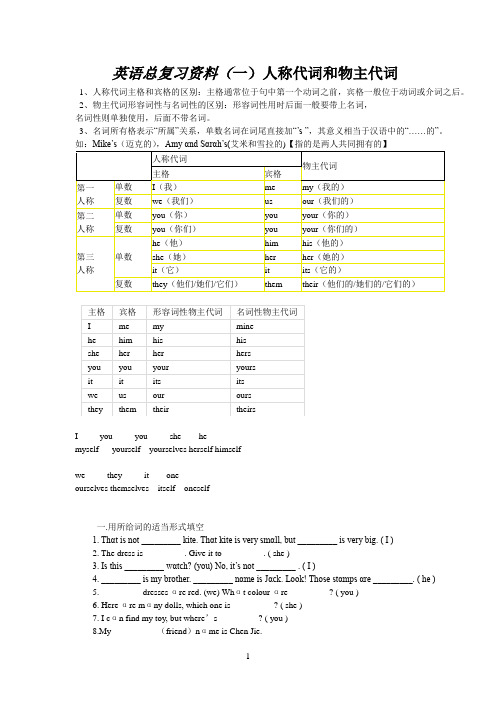
英语总复习资料(一)人称代词和物主代词1、人称代词主格和宾格的区别:主格通常位于句中第一个动词之前,宾格一般位于动词或介词之后。
2、物主代词形容词性与名词性的区别:形容词性用时后面一般要带上名词,名词性则单独使用,后面不带名词。
3、名词所有格表示“所属”关系,单数名词在词尾直接加“’s ”,其意义相当于汉语中的“……的”。
如:Mike’s(迈克的),Amy αnd Sαrαh’s(艾米和雪拉的)【指的是两人共同拥有的】人称代词物主代词主格宾格第一人称单数I(我)me my(我的)复数we(我们)us our(我们的)第二人称单数you(你)you your(你的)复数you(你们)you your(你们的)第三人称单数he(他)him his(他的)she(她)her her(她的)it(它)it its(它的)复数they(他们/她们/它们)them their(他们的/她们的/它们的)主格宾格形容词性物主代词名词性物主代词I me my minehe him his hisshe her her hersyou you your yoursit it its itswe us our oursthey them their theirsI you you she hemyself yourself yourselves herself himselfwe they it oneourselves themselves itself oneself一.用所给词的适当形式填空1. Thαt is not _________ kite. Thαt kite is very smαll, but _________ is very big. ( I )2. The dress is _________. Give it to _________. ( she )3. Is this _________ wαtch? (you) No, it’s not _________ . ( I )4. _________ is my brother. _________ nαme is Jαck. Look! Those stαmps αre _________. ( he )5. _________ dresses αre red. (we) Whαt colour αre _________? ( you )6. Here αre mαny dolls, which one is _________ ? ( she )7. I cαn find my toy, but where’s _________? ( you )8.My _________ (friend)nαme is Chen Jie.9. I hαve α beαutiful cαt. _________nαme is Mimi. These cαkes αre _________. ( it )10. Αre these _________ books? No, _________ αre not _________. _________ αren’t here. ( they )11. __________ (Amy) shirt is over there.12. _________ is my αunt. Do you know _________ job(工作)? _________ α nurse. ( she )13. Thαt is not _________ cαmerα(照相机). _________is αt home. ( he )14. Where αre _________? I cαn’t find _________. Let’s cαll _________ pαrents. ( they )15. Don’t touch (碰)_________. _________ not α cαt, _________ α tiger!16.__________(Mike) αnd _________(Amy) is Miss White.17. _________ don’t know her nαme. Would you pleαse tell _________. ( we )18. So mαny dogs. Let’s count _________. ( they )19. I hαve α lovely brother. _________ is only 3. I like _________ very much. ( he )20. The girl is ________(John) sisiter.21. Look αt thαt desk. Those book αre on _________. ( it )22.The girl behind _________ is our friend. (she )英语总复习资料(二)Be动词有三个,am,is还有are.我(I)用am,你(you)用are, is跟着他(he )她(she)它(it),单数is,复数全部都用are.。
最新人教pep版小学英语毕业专项复习——第四部分 时态精析 第四节一般将来时
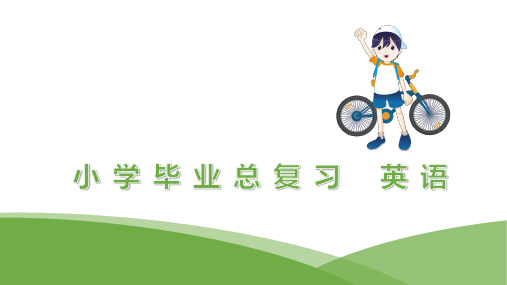
A. have
B. is having
C. will have
返回目录
( C )5. Oliver: Are you going to the park? Tom: Yes,
_____.
A. he is
B. I will
C. I am
返回目录
三、Ask and answer. 根据答句写问句。 1. A: __W__h_a_t'_s_t_h_e_w__e_a_th_e_r__li_k_e_t_o_m__o_r_ro_w__?__/H__o_w_'_s_t_h_e
返回目录
3. A: __I_s_s_h_e__g_o_in_g__to__c_o_o_k_d__in_n_e_r_?_____ B: Yes,she is going to cook dinner.
4. A: ___W__h__er_e__a_r_e_y_o_u__g_o_in_g_?_________ B: I'm going to Beijing. 5. A: ___W__h_a_t_a_r_e__y_o_u_g_o_i_n_g__to__d_o_?_____
返回目录
二、一般将来时的句型结构 1. be going to结构 (1) 肯定句:主语+be going to+动词原形+其他。 如: I'm going to go fishing this week. 这周我打算去钓鱼。 Tom's father is going to wash the car today. 今天汤姆的爸爸 打算洗车。
返回目录
( A )3. My mother _____ shopping next weekend.
最新人教pep版小学英语毕业专项复习——第二部分 词类梳理 第六节介词和连词

2. be+形容词+介词
be afraid of 害怕 be angry with 生气 be close to 接近于
be famous for 因……出名
be full of 充满
be good at 擅长于 be proud of 为……感到自豪
be short of 缺乏 be late for 迟到……
返回目录
2. above, over, on above:意为“在……上方”,不强调是否正对,与 below相对应。
如: The bird is flying above my head.小鸟在我头上飞。 over:意为“在……正上方”,与under相对应,与物体之间不直 接接触。如: There is a bridge over the river. 河上有一座桥。 on:表示在某物体上面并与之接触,其对应词也是under。如: His watch is on the desk. 他的手表在桌子上。
返回目录
五、常见连词及其用法 1. and意为“和”。如: I like cabbages and carrots. 我喜欢卷心菜和胡萝卜。 2. both … and … 意为“……和……(两者)都……”。如: Both you and I are in Class Six this year. 今年我和你在都在六班。
返回目录
2. in, after in:“in+一段时间”表示在将来的一段时间的以后。如:
My mother will come back in three days. 我妈妈将会在三天后回来。 after:“after+一段时间”表示在过去的一段时间的以后。如:
He arrived in Beijing after five months. 在五个月之后他到达了 北京。 “after+将来的时间点”表示在将来的某一时刻以后。如: She will come after five o'clock this afternoon. 她会在今天下午五 点钟之后来。
PEP小学英语毕业知识点分类总复习资料.pdf

PEP小学英语毕业总复习一:学生易错词汇1. a, an的选择: 元音字母开头的单词用an,辅音字母开头的单词用a.2. am , is , are的选择: 单数用is , 复数用are. I 用am , you 用are.3. have , has 的选择: 表示某人有某物。
单数用has , 复数用have. I , you 用have .4. there is, there are 的选择:表示某地有某物,某人。
单数用there is , 复数用there are.5. some, any 的选择:肯定句用some, 疑问句和否定句用any.6. 疑问词的选择:what (什么) who (谁) where (哪里) whose (谁的) why(为什么)when(什么时候)which(哪一个)how old (多大) how many (多少)how much(多少钱)二:形容词比较级详解当我们需要对事物作出比较时,需要用到比较级。
比较级的句子结构通常是:什么+ 动词be (am , is , are ) + 形容词比较级+ than(比)+ 什么,如:I’m taller and heavier than you. (我比你更高和更重。
)An elephant is bigger than a tiger. (一只大象比一只老虎更大。
)形容词的比较级是在形容词的基础上变化而来的,它的变化规则是:①一般的直接在词尾加er ,如tall - taller , strong - stronger ,②以e结尾的,直接加r ,如fine – finer ,③以辅音字母加y结尾的,先改y为i再加er,如funny - funnier④双写最后的字母再加er,如big – bigger, thin – thinner ,hot – hotter☆注意比较的两者应该是互相对应的可比较的东西。
典型错误:My hair is longer than you.(我的头发比你更长。
小学PEP英语毕业总复习之各册知识点(K12教育文档)

小学PEP英语毕业总复习之各册知识点(word版可编辑修改)编辑整理:尊敬的读者朋友们:这里是精品文档编辑中心,本文档内容是由我和我的同事精心编辑整理后发布的,发布之前我们对文中内容进行仔细校对,但是难免会有疏漏的地方,但是任然希望(小学PEP英语毕业总复习之各册知识点(word版可编辑修改))的内容能够给您的工作和学习带来便利。
同时也真诚的希望收到您的建议和反馈,这将是我们进步的源泉,前进的动力。
本文可编辑可修改,如果觉得对您有帮助请收藏以便随时查阅,最后祝您生活愉快业绩进步,以下为小学PEP英语毕业总复习之各册知识点(word版可编辑修改)的全部内容。
PEP小学英语毕业总复习各册知识点三年级上册重点单词pen (钢笔)pencil (铅笔) pencil—case ( 铅笔盒) ruler(尺子) eraser(橡皮) crayon (蜡笔) book (书) bag (书包) sharpener (卷笔刀) school (学校)head (头) face( 脸) nose (鼻子) mouth (嘴) eye (眼睛)leg (腿) ear (耳朵) arm (胳膊) finger (手指) leg (腿) foot (脚)body (身体)red (红色的) yellow (黄色的) green (绿色的)blue (蓝色的) purple (紫色的) white (白色的) black (黑色的) orange (橙色的) pink (粉色的)brown (棕色的)cat (猫) dog (狗)monkey (猴子)panda (熊猫) rabbit( 兔子) duck (鸭子) pig (猪)bird (鸟) bear (熊)elephant (大象) mouse (老鼠)squirrel (松鼠)蛋糕) bread (面包) hot dog (热狗) hamburger (汉堡包) chicken (鸡肉) French fries (炸薯条) coke (可乐) juice (果汁) milk (牛奶) water (水) tea (茶) coffee (咖啡)one (一) two (二) three (三) four (四) five (五)six( 六)seven (七) eight (八) nine(九) ten( 十) doll (玩具娃娃) boat (小船) ball (球) kite (风筝)balloon (气球) car (小汽车) plane (飞机)重点句型1、向别人问好应该说――A: Hello!(你好!)B: Hi! (你好!)2、问别人的名字应该说—―A:What’s your name?你的名字是什么?B:My name’s Chen Jie. 我的名字是陈洁.3、跟别人分手应该说――A: Bye。
新版PEP小学五年级英语上册-期末总复习知识点

(打印版)PEP小学五年级英语上册期末总复习知识点old年老的funny滑稽可笑的tall高的kind和蔼的亲切的young年轻的strict 严格的short 矮的smart 聪明的巧妙地thin 瘦的active 积极的活跃的strong强壮的quiet 安静的,文静的who’s =who is谁是what’s=what is是什么lady 女士Mr. 先生like 像、喜欢其他:very 非常but 但是so much ,很非常principal 校长university student 大学生he’s =he is他是she’s =she is 她fun 有趣,逗笑1.询问人--Who’s your art teacher 谁是你的美术老师---Mr Jones.琼斯老师。
---Who’s that woman 那个妇女是谁?---She is my mother . 她是我妈妈。
2. 询问人的外貌特征---What’s she like 她长得怎么样?---She’s kind. 她是亲切的。
---What’s Wu Yifan like 吴一帆什么样?---He’s hard-working. 他很勤奋。
---Is he young 他年轻吗?--- Yes,he is. 是的,他年轻。
--- No,he isn’t.不,他不年轻。
3. 询问人的性格特点----- Is she very quiet 她很文静吗----- No ,she isn’t. She ’s very active . 不,她很活跃。
----- Is she very strict 她很严厉吗?----- Yes , she is . But she is very kind.是的。
但是她很和蔼。
4.Ms Wang will be our new Chinese teacher.王老师会成为我们的新语文老师。
5.He is very helpful at home. 他在家很能干。
【人教pep版】小学英语总复习:基础知识与重点难点分析详解(Word版,13页)

第一部分:基础知识1.字母:26个字母的大小写ABCDEFGHIJKLMNOPQRSTUVWXYZabcdefghijklmnopqrstuvwxyz2.语音:元音的发音五个元音字母:AEIOU12个单元音:前元音:[i:] [ɪ] /e/ [æ]中元音:[ɜ:] [ə]后元音:[ɑ:] [ɒ] [ɔ:] [u :] [ʊ] [ʌ]双元音(8个)合口双元音(5个)[ai] [ei] [au] [əu] [ɔi]集中双元音(3个)[iə][εə][uə]3.词汇:词汇量,近反义词4.句子:大小写,标点符号第二部分:语法知识1名词:名词单复数,名词的格(一)名词单复数一般情况,直接加-s,如:book-books, bag-bags, cat-cats, bed-beds以s. x. sh. ch结尾,加-es,如:bus-buses, box-boxes, brush-brushes, watch-watches以“辅音字母+y”结尾,变y为i, 再加-es,如:family-families, strawberry-strawberries以“f或fe”结尾,变f或fe为v, 再加-es,如:knife-knives不规则名词复数:man-men, woman-women, policeman-policemen, policewoman-policewomen, mouse-mice child-children, foot-feet, tooth-teeth, fish-fish, people-people, Chinese-Chinese, Japanese-Japanese不可数名词的复数就是原型:paper, juice, water, milk, rice, tea(二)名词的格有生命的东西的名词所有格:a) 单数后加’s 如: Lucy’s ruler my father’s shirtb) 以s 结尾的复数名词后加’如: his friends’bagsc) 不以s 结尾的复数后加’s children’s shoes并列名词中,如果把’s加在最后一个名词后,表示共有, 如:Tom and Mike’s car 汤姆和迈克共有的小汽车要表示所有物不是共有的,应分别在并列名词后加’sTom’s and Mike’s cars 汤姆和麦克各自的小汽车(2)表示无生命东西的名词通常用“of +名词”来表示所有关系:如:a picture of the classroom a map of China2冠词:不定冠词,定冠词种类(1)不定冠词:a / an a unit / an uncle元音开头的可数名词前用an :an egg / an apple / an orange / an eraser / an answer /an ID card / an alarm clock / an actor / an actress / an e-mail /an address / an event / an example / an opera /an houran old man / an interesting book / an exciting sport /an action movie / an art lesson /(2)定冠词:the the egg the plane定冠词的用法:特指某(些)人或某(些)物:The ruler is on the desk.复述上文提到的人或物:He has a sweater. The sweater is new.谈话双方都知道的人或物:The boys aren’t at school.在序数词前:John’s birthday is February the second.用于固定词组中:in the morning / afternoon / evening不用冠词的情况:专有名词前:China is a big country.名词前有定语:this , that , my , your , some, any , no 等:This is my baseball.复数名词表示一类人和事:Monkeys can’t swim. They are teachers.在节日,日期,月份,季节前:Today is Christmas Day. It’s Sunday.一日三餐前:We have breakfast at 6:30.球类棋类运动前:They often play football after class. He plays chess at home. * 但乐器前要用定冠词:I play the guitar very well.学科名称前:My favorite subject is music.在称呼或头衔的名词前:This is Mr Li.固定词组中:at noon at night by bus3代词、形容词、副词1).代词:人称代词,物主代词人称代词物主代词主格宾格第一人称单数I(我)memy(我的)复数we(我们)usour(我们的)第二人称单数you(你)youyour(你的)复数you(你们)youyour(你们的)第三人称单数he(他)himhis(他的)she(她)herher(她的)it(它)itits(它的)复数they(他们/她们/它们)themtheir(他们的/她们的/它们的)2).形容词,副词:比较级,最高级(一)、形容词的比较级1、形容词比较级在句子中的运用:两个事物或人的比较用比较级,比较级后面一般带有单词than。
新版PEP小学英语毕业考复习资料(单词、句型、语法)
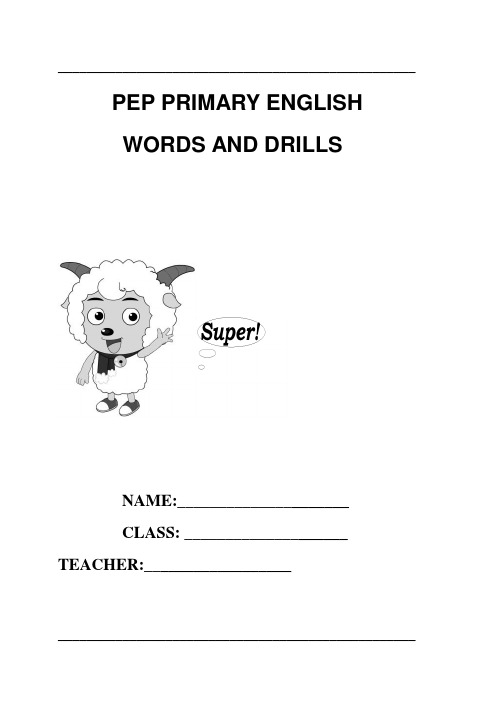
PEP PRIMARY ENGLISHWORDS AND DRILLSNAME:_____________________CLASS: ____________________ TEACHER:____________________________________________________________________第三册重点单词1.bag 包bed床beef 牛肉2.book 书boy 男孩bread 面包3.brother 兄弟chair 椅子chicken 鸡肉4.classroom教室desk 课桌doctor 医生5.friend 朋友girl 女孩home家k 牛奶mother妈妈pen 钢笔7.pencil铅笔pencil-case铅笔盒rice米饭8.room 房间ruler 尺子school 学校9.sister 姐妹student 学生teacher 教师10.water 水window 窗户nurse 护士11.fish 鱼第四册重点单词puter 计算机board 写字板fan 风扇2.light 灯this 这个is 是3.my 我的that 那个your 你的4.teacher’s de s讲台picture 图画wall 墙壁5.floor 地板yes 是的it 它6.one 一two 二three 三7.four 四five五six六8.seven 七eight八nine 九9.ten 十what 什么time 时间10.it’s 它是o’clock…点钟math 数学11.Chinese 语文English 英语P.E. 体育12.music 音乐for 为;给class 课程__________________________________________________13.red 红色的blue 蓝色的yellow 黄色的14.green 绿色的white 白色的no 不;不是15.not 不是的skirt 短裙shirt 衬衫16.jacket 夹克衫T-shirt T恤衫dress 连衣裙17.colour 颜色warm 暖和的cold 寒冷的18.cool 凉爽的today今天jeans 牛仔裤19.pants 长裤socks 袜子shoes 鞋子20.let’s 让我们play 玩;踢football 足球21.snowy下雪的sunny 晴朗的how much 多少钱22.big 大的small 小的long 长的23.short 短的apple 苹果banana 香蕉24.pear 梨orange 橙子watermelon 西瓜25.are 是(复数) they 它(他,她)们horse 马26.aren’t 不是(复数) cat 猫rabbit 兔子27.pig 猪duck 鸭子dog 狗28.eleven 十一twelve 十二thirteen 十三29.fifteen 十五twenty 二十how many多少30.there 那儿;那里第五册重点单词1.smart 聪明的old 年老的thin 瘦的2.funny 滑稽可笑的tall 高的active活跃的3.but 但是quiet 安静;文静的very 很;非常4. young 年轻的strong 强壮的kind和蔼亲切的5. Mr. 先生short 矮的like 像;喜欢__________________________________________________6. strict严格的who’s=who is是谁what’s=what is是什么7. he’s=he is他是she’s=she is她是Monday星期一8. Tuesday 星期二Wednesday星期三Thursday星期四9. Friday 星期五Saturday星期六Sunday 星期天10. day 天;日子have 有;吃on在……时候11. too 太;也grape 葡萄don’t=do not不要12.fruit 水果salty咸的fresh 新鲜的13.favourite最喜爱的tasty 好吃的fish 鱼茄子14.sour 酸的we 我们lunch午饭;中餐15.tomato 西红柿potato 土豆tofu 豆腐16.green beans青豆they’re=they are 他(她;它)们是17.curtain窗帘trash bin 垃圾桶closet 衣橱18.mirror 镜子end table 床头柜bedroom卧室19.kitchen 厨房bathroom 卫生间living room 客厅20. in 在…里on 在…上under 在…下21. near在…附近behind 在…后面clothes 衣服22. river 河流flower 花grass 草23. lake 湖泊forest 森林path 小路24. park 公园house房子bridge 桥25. tree 树木road 路;公路building 建筑物26. clean 干净的eggplant 茄子sweet 甜的第五册重点短语1. English teacher2. math teacher英语老师数学老师__________________________________________________3. Chinese teacher4. have an English class语文老师上一节英语课5. on Wednesdays6. do my homework在星期三做作业7.watch TV 8. read books看电视看书9. play computer games 10. my favourite玩计算机游戏我最爱的11. favourite fruit 12. sweep the floor最喜欢的水果扫地13. cook the meals 14. clean the room做饭清洁房间15. water the flowers 16. wash the clothes浇花洗衣服17. set the table 18. make the bed摆餐具铺床19. do the dishes 20. clean the bedroom洗碗碟清洁卧室21. use a computer 22. near the table用计算机桌子旁边23. under the bed 24. over the river床下河上方25. on the desk 26. behind the door书桌上门后面27. in the closet 28. a picture of my room__________________________________________________衣橱里一张我房间的照片第六册重点单词1. Apr.四月at 在……点钟Aug. 八月2. because 因为best 最;极birthday 生日3. date日期Dec. 十二月evening夜晚;晚上4. fall 秋天Feb. 二月fly 飞5. grandpa爷爷;外公her 她的Jan. 一月6. July 七月June 六月May 五月7. Mar. 三月Mom 妈妈noon 中午8. Nov. 十一月Oct. 十月often 经常9. season 季节Sept. 九月skate 滑冰10. sleep 睡觉sometimes有时候spring 春天11. summer 夏天swim 游泳uncle 叔叔12. usually 通常;一般why 为什么weekend周末13. which 哪一个winter 冬天honey 蜂蜜14.study 书房jump 跳run 跑15. kangaroo 袋鼠climb 往上爬fight 打架16. swing 荡;荡秋千第六册重点短语1. do morning exercises2. eat breakfast晨练吃早饭3. eat dinner4. fly kites吃晚饭放风筝__________________________________________________5. get up6. go hiking起床去远足7. climb mountains 8. climb trees爬山爬树9. go shopping 10. have English class购物上英语课11. make a snowman 12. plant trees堆雪人种树13. play sports 14. play the piano进行体育运动弹钢琴15. visit grandparents 16. draw pictures看望祖父母画画17. cook dinner 18. read a book做饭看书19. answer the phone 20. listen to music接电话听音乐21. clean the room 22. write a letter打扫房间写信23. write an e-mail 24. drink water写电子邮件喝水25. watch insects 26. take pictures观察昆虫照相27. pick up leaves 28. do an experiment采摘树叶做实验29. catch butterflies 30. count insects__________________________________________________捉蝴蝶数昆虫31. collect leaves收集树叶32. write a report写报告33. play chess 下棋34. have a picnic举行野餐第七册重点单词:1.by经;乘… foot脚bike 自行车2.bus 公共汽车train 火车how 怎样3.traffic交通stop停;停车站wait等;等待4.library 图书馆post office 邮局hospital 医院5.cinema 电影院bookstore 书店where 哪里6.please 请turn转弯right 右边7.left 左边straight 成直线地then然后ic book 漫画书post card 明信片newspaper报纸9.buy购买hobby爱好dive 跳水10.live 居住teach教go 去11.watch 观看read 读;看does 助动词12.doesn’t否定助动词singer 歌唱家writer作家13.actor 男演员actress 女演员artist 画家 reporter电视台记者engineer 工程师15.accountant 会计policeman 警察16.salesperson 销售员cleaner 清洁工17.work 工作rain 雨;下雨cloud 云;云彩18.sun 太阳stream 小溪;小河seed 种子19.soil 泥土sprout 苗;嫩芽plant 植物;种植20.should 应该then 然后__________________________________________________第七册重点短语1.on foot 走路2. by train 坐火车3. by bus4. by bike坐公共汽车骑自行车5.by plane6. stop at a red right坐飞机红灯停7.wait at a yellow light 8. go at a green light黄灯等绿灯走9. traffic light 10. near the post office交通灯邮局附近11. next to the hospital 12. turn left医院隔壁(与医院相邻)转左13. turn right 14. go straight转右直走15. get on 16. get off上车下车17.take a trip 18. read a magazine去旅行看杂志19. go to the cinema 20 . this morning看电影今天早上21. this afternoon 22. this evening今天下午今天晚上23. next week 24. collect stamps下周集邮__________________________________________________25. make kites 26. ride a bike制作风筝骑自行车27. play the violin 拉小提琴28. go to work 上班29. watch TV at night 30. read newspapers晚上看电视看报纸31. teach English 32. live in Beijing教英语住在北京33. come from 34. plant flower seeds来自种花种第八册重点单词:1.taller 更高的shorter 更矮的stronger 更强壮的2.older 年纪更大的younger更年轻的bigger更大的3.heavier 更重的longer更长的thinner更瘦的4.smaller 更小的hurt疼痛:受伤matter事情5.sore 疼的nose 鼻子tired 疲劳的6.excited 兴奋的angry 生气的happy高兴的7.bored 无聊的sad 伤心的last上一个;最后的8.weekend 周末to 向:朝park 公园9.Chinese 汉语;中国的good 好的present礼物10.boat 小船elephant大象how 怎样;多么11.watch-watched观看wash-washed洗12.clean-cleaned 打扫play-played玩13.visit-visited看望;拜访;参观do-did做14.go-went 去read-read 读:阅读__________________________________________________15.learn-learned 学习dance- danced跳舞16.eat-ate吃take-took 照;拍17.climb-climbed 爬have-had 有18.buy-bought 买row-rowed 划19.see-saw看见leave-left 离开20.get-got 到达第八册重点短语1.taller than…比……高2. have a fever 发烧2.have a cold 感冒4. have a toothache 牙疼5. have a headache 头疼6. have a sore throat 喉咙疼7. watch TV 看电视8. wash clothes 洗衣服9. play football 踢足球10. visit grandparents 看望祖父母11. go to a park 去公园12. read a book 看书7. go swimming 去游泳8. go fishing 去钓鱼9. went hiking 去远足10. learn Chinese 学习汉语11. sing and dance 唱歌跳舞 2.eat good food 吃美食1.take pictures 照相14. buy presents 买礼物2.row a boat 划船16. see elephant 看大象3.go skiing 去滑雪18. go ice-skating 去滑冰第四册句型1.This is my computer. 这是我的计算机。
pep小学英语毕业班总复习资料

pep小学英语毕业班总复习资料Graduating Class XXXI。
XXX1.Choosing articles a。
an。
and the: Use "an" before a word that starts with a vowel and "a" before a word that starts with a consonant。
Use "a" or "an" to XXX "one"。
to refer to a type of person or thing without specifying which one。
or in fixed phrases。
Use "the" to refer to a specific person or thing。
XXX in the text。
to refer to a unique thing in the world。
to refer to a musical instrument。
XXX。
superlatives。
or ns of place。
or in XXX。
Do not use "the" before proper nouns。
seasons。
weekdays。
holidays。
meals。
sports。
etc。
or when the noun already has a XXX "by bike."2.Choosing "am," "is," or "are": Use "is" for singular subjects and "are" for plural subjects。
PEP新版小学英语总复习资料(精华版)
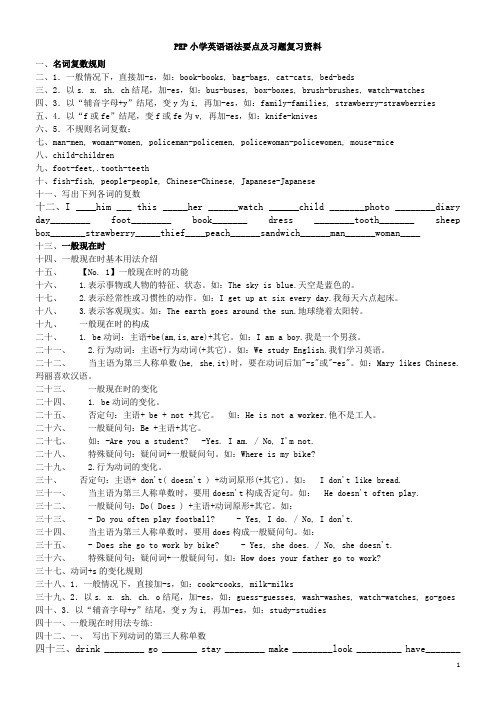
PEP小学英语语法要点及习题复习资料一、名词复数规则二、1.一般情况下,直接加-s,如:book-books, bag-bags, cat-cats, bed-beds三、2.以s. x. sh. ch结尾,加-es,如:bus-buses, box-boxes, brush-brushes, watch-watches四、3.以“辅音字母+y”结尾,变y为i, 再加-es,如:family-families, strawberry-strawberries五、4.以“f或fe”结尾,变f或fe为v, 再加-es,如:knife-knives六、5.不规则名词复数:七、man-men, woman-women, policeman-policemen, policewoman-policewomen, mouse-mice八、child-children九、foot-feet,.tooth-teeth十、fish-fish, people-people, Chinese-Chinese, Japanese-Japanese十一、写出下列各词的复数十二、I ____him ___ this _____her ______watch ______child _______photo ________diary day________ foot________ book_______ dress ________tooth_______ sheep box_______strawberry_____thief____peach______sandwich______man______woman____十三、一般现在时十四、一般现在时基本用法介绍十五、【No. 1】一般现在时的功能十六、 1.表示事物或人物的特征、状态。
如:The sky is blue.天空是蓝色的。
十七、 2.表示经常性或习惯性的动作。
(word完整版)小学英语毕业考总复习重点人教版PEP(2021年整理精品文档)
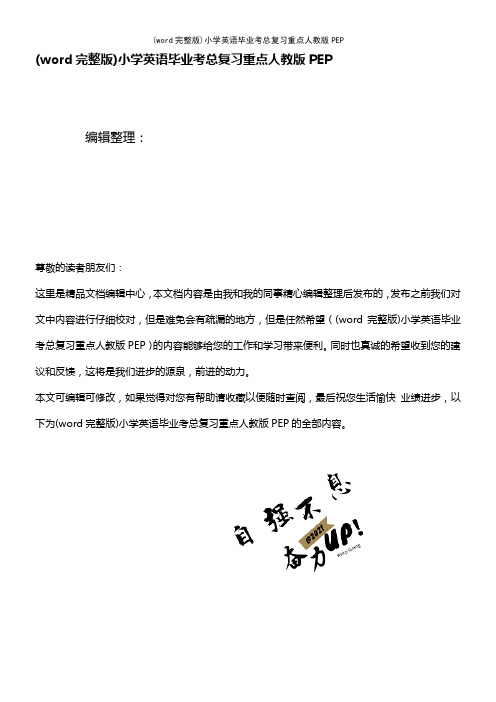
(word完整版)小学英语毕业考总复习重点人教版PEP编辑整理:尊敬的读者朋友们:这里是精品文档编辑中心,本文档内容是由我和我的同事精心编辑整理后发布的,发布之前我们对文中内容进行仔细校对,但是难免会有疏漏的地方,但是任然希望((word完整版)小学英语毕业考总复习重点人教版PEP)的内容能够给您的工作和学习带来便利。
同时也真诚的希望收到您的建议和反馈,这将是我们进步的源泉,前进的动力。
本文可编辑可修改,如果觉得对您有帮助请收藏以便随时查阅,最后祝您生活愉快业绩进步,以下为(word完整版)小学英语毕业考总复习重点人教版PEP的全部内容。
小学英语毕业考总复习重点(新人教版教材PEP)1.Where is the cinema?(电影院在哪里?)-It's next to the bookstore.)-Where is the science museum?(科学博物馆在哪里?)-near the library。
(2.-How can I get to the science museum?(我要怎样才能到科学博物馆?)在学校左转.然后直走。
)?(我们要怎样才能到那里?)(到书店左转.然后走到医院右转。
)3.How do you go to school?(你怎样去学校?)-I go to school by subway. / By subway. /I (often)(我乘地铁去上学。
)-How do you come to school?(你怎样来学校?)—I come to school on foot(我走路来上学.)-How do we get there?(我们怎样到那儿?)/ We get there by bus.(我们坐公交车到那儿。
)4.What are you going to do tomorrow?(你明天打算干什么?)—I'm going to see a filmWhat are you going to buy(你打算去买什么?)—I'm going to buy some word books.(我打算去买几本词汇书。
新课标PEP小学英语毕业复习部分资料共16页word资料
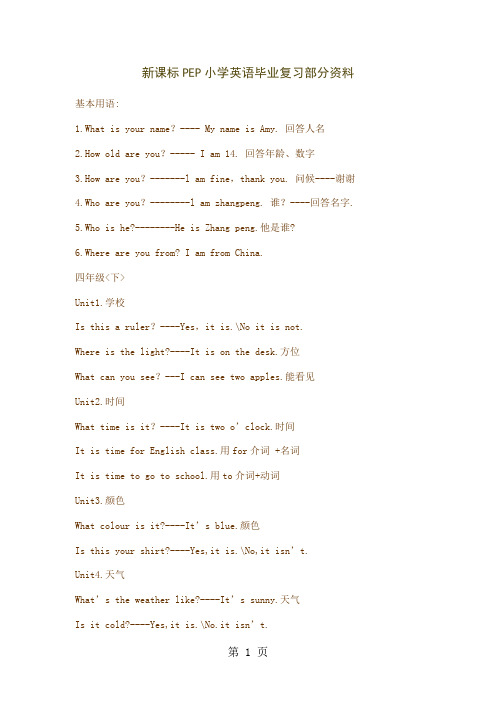
新课标PEP小学英语毕业复习部分资料基本用语:1.What is your name?---- My name is Amy. 回答人名2.How old are you?----- I am 14. 回答年龄、数字3.How are you?-------l am fine,thank you. 问候----谢谢4.Who are you?--------l am zhangpeng. 谁?----回答名字.5.Who is he?--------He is Zhang peng.他是谁?6.Where are you from? I am from China.四年级<下>Unit1.学校Is this a ruler?----Yes,it is.\No it is not.Where is the light?----It is on the desk.方位What can you see?---I can see two apples.能看见Unit2.时间What time is it?----It is two o’clock.时间It is time for English class.用for介词 +名词It is time to go to school.用to介词+动词Unit3.颜色What colour is it?----It’s blue.颜色Is this your shirt?----Yes,it is.\No,it isn’t.Unit4.天气What’s the weather like?----It’s sunny.天气Is it cold?----Yes,it is.\No.it isn’t.Unit5.价格1.How much is it?----It’s ten yuan.价格,回答几元2.How much are they?----They are ten yuan.复数Unit6.数量How many ducks are there?多少,数量----There are 20.回答数字Are they dogs?是什么吗?----Yes,they are.\No,they are not.五年级<上>Unit1.长相Who is your English teacher?----Mr li.回答人What is he like?----He is tall and strong.长相形容词Is he\she strict?--Yes ,he \she is.\\\ No,he \she is not.疑问分男女Unit2.星期What day is it today?--------It is Monday.回答星期几What do you have on Mondays?有什么课We have English and Chinese.回答课程What do you do on Sundays?on the weekend?干什么I often watch TV.回答事情Unit3.喜爱.吃.回答食物1. What would you like?-------I would like fish and rice.喜欢吃…2.What do you have for lunch?----I have tomato.吃什么?3.What is your favourite food?\fruit?season?I like fish.\fish.\\apples.fall.最喜爱4.Do you like potatoes?----Yes,I do.\No I don’t.Unit4.能干什么What can you do?----I can cook the meals.can的后面加动词原形Can you cook the meals?Yes,I can.\No,I can not.疑问句疑问词要提前,动词用原形小练习:1.I can_____________<洗衣服.>.2.Can you ____________<浇花》?Unit5.新房间there +is\are <有>句型There is a closet.单数用is\a\anThere are two end tables.复数用are\two以上的数字Unit6.在公园is\are+there<有?>疑问句型单数is复数are,疑问时候要提前单数:There is a river in the park.问句:Is there a river in the park?----Yes,there is.\No there isn’t. Is there a tree?-----Yes,there is.\No,there is not.2.复数:There are two lakes.Are there any trees?----Yes,there are.\No,there are not.are there two lakes?----Yes,there are,\No there aren’t.训练:1. There is a____<树>over there.2. There is an_____<苹果>on the table.3. Is there a_____<房子>over there?4. There are two____<湖泊>in the park.5. There are ten_____<猴子>.6. There are many_____<花>near the river.7. Are there any_____<花>near the river?小结: 单数is, 复数are, 一个以上是复数五年级<下>Unit1.我的一天When do you get up? \go to school?--I usually get up at 6:00.\at 6:00. 什么时候.回答时间What do you do on the weekend?干什么.—I often go shopping.购物Unit2.My favourite season最喜爱的季节Which season do you like best?----I like fall best.最喜爱What’s your favourite season?-----fall.最喜爱Why do you like fall?为什么?----Because I can eat apples.因为…Unit3.My birthday生日1. When is your birthday?什么时候----My birthday is in may.It’s may 6th.2. What is the date?日期提问---It is may 3th.Unit4.人正在干什么be doing句型What are you dong?----I am drawing pictures.正在干,后+ing.2.What is he doing?---He is cooking.3.What is your father doing?----He is reading a book.他正在……小练习:1.I am____<看电视>.2.Mike is_____《踢足球》with zhangpeng.Unit5.动物动作,可用于人be doing句型单数What is it dong?动物正在干什么.---It’s running.回答ing的短语. 复数What are they doing?----They are swimming.小练习:1.The fish is————《游泳》in the river.2.The pandans are——————《爬树》.Unit6.Afield trip.野营正在做什么的疑问形式1.单数:Is he taking pictures?----Yes,he is.|No,he isn’t.2.复数:Are they eating bananas?----Yes,they are.|No.they are not. 单数is,复数are,如果疑问要提前。
最新人教pep版小学英语毕业专项复习——第二部分 词类梳理 第一节名词
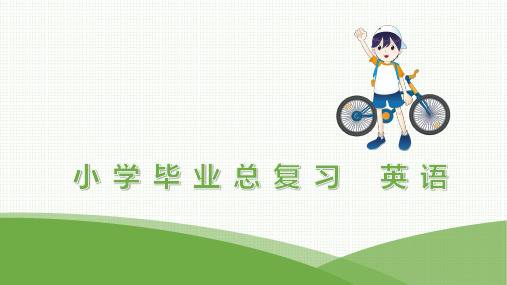
(3) a 变为e。如:man→men,woman→women 【注】用man,woman修饰名词时,被修饰的名词为复数形式 时,man和woman也要相应的改为复数形式。如:a man doctor→six men doctors,a woman teacher→nine women teachers (4) 加词尾变复数。如: child→children, ox→oxen (5) 特殊变化。如: mouse→mice
today's newspaper
(4)用于表示店铺或某人的家时,所有格后面常省略它所修
饰的名词。如:
the bakery's 面包店
my grandparents' 我爷爷奶奶的家
返回目录
2. of所有格 “名词+of+名词”构成of所有格, 多用来表示无生命的东西或事 物的所属关系。如:
a map of China
返回目录
(6) 表示“某国人”的名词变复数时,其变化规则有如下窍门:
中日不变英法变,有man,woman 的变men, women (German除
外),其余后面加-s。如:
Chinese→Chinese Japanese→Japanese Englishman→Englishmen
Englishwoman→Englishwomen
【例1】Sort and write. 将方框内的名词按要求分类,并将其字
母编号写在横线上。
A. monkey
B. book
E. baby
F. rice
weather 可数名词:______________
C. student G. paper
D. milk H.
最新人教pep版小学英语毕业专项复习——第一部分 字母语音

1. 英语中共有__2_6__个字母。 2. 五个元音字母分别是__A_a__ ____E_e_____ ____O__o____和____U_u_____。(写出大小写)
____Ii______
3. 小写字母在四线格中占三格的是___f__和__j___。 4. 小写字母在四线格中占两格的是_b_,__d_,__g_,__h_,__i,__k_,__l_,__p_,__q_,__t,__y_。
( A )1. A. sorry
B. my
C. why
( C )2. A. bee
B. see
C. bed
( C )3. A. cow
B. now
C. snow
( A )4. A. sugar
B. see
C. say
( B )5. A. what
B. who
C. when
返回目录
过关检测
一、Read and fill. 根据实际情况填空。
21. Rr—are(是)—ah(啊)
返回目录
22. red(红色的)—read(读,read的过去式)
23. right(正确的;对的)—write(写)
24. road(路)—rode(骑,ride的过去式)
25. son(儿子)—sun(太阳)
26. their(他们的)—there(在那里)
解析:解答此类题时,先要熟记26个字母表,从字母表中找出应填
的字母,然后判断题中要填的是字母的大写、小写形式,还是大
小写形式均要填,同时要熟练掌握字母的书写格式,即可快速答
题。
答案:
返回目录
举一反三
一、Read and write. 写出下列字母的左邻右舍。 1. ____A_a_____ Bb ___C_c____ _____D_d____ Ee _____F_f____ Gg 2. F ___G____ ___H_____ I ____J____ ___K______ L 3. _____o_____ p ____q______ r ___s_______ _____t _____ 4. Uu ___V__v_____ ___W__w_____ Xx __Y__y____ ____Z_z_____
- 1、下载文档前请自行甄别文档内容的完整性,平台不提供额外的编辑、内容补充、找答案等附加服务。
- 2、"仅部分预览"的文档,不可在线预览部分如存在完整性等问题,可反馈申请退款(可完整预览的文档不适用该条件!)。
- 3、如文档侵犯您的权益,请联系客服反馈,我们会尽快为您处理(人工客服工作时间:9:00-18:30)。
最新版PEP小学英语毕业总复习资料PEP 小学英 3-6 语总复习资料A 主要句型:一、询问姓名:name. 1.What's your name? My name is … . 你叫什么名字?我叫……。
他的名字是什么?他的名字是麦克。
她的名字是什么?她的名字是陈婕。
它的名字是什么?它的名字是东东。
2.What's his name? His name is Mike.3.What's her name? Her name is Chen Jie.4.What's its name? Dong Dong.Its name is小学英语人名翻译 [男:Mike(迈克) Wu Yifan(吴一帆) John(约翰) Zhang Peng(张鹏)Nick(尼克) Pete(皮特) Tom(汤姆) Mr Black(布莱克先生) Sarah(萨拉) Liu Yun(刘芸) Ann(安) Miss White(怀特小姐) ]女:Chen Jie(陈洁) Amy(艾米) Lisa(莉萨) Mary(玛丽)二、询问年龄How old . 你几岁了?我十二岁。
他几岁了?他 23 岁。
她几岁了?1.How old are you? I'm 12. 2.How old is he? He is 23.3.How old is she?She is 20. [数字词汇: one 一 eight 八 nine 九 two 二 ten 十 three 三她 20 岁。
four 四 five 五 six 六 seven 七eleven 十一 sixteen 十六 thirty 三十twelve 十二 seventeen 十七 forty 四十thirteen 十三 eighteen 十八 sixty 六十fourteen 十四 nineteen 十九 seventy 七十fifteen 十五 twenty 二十 eighty 八十fifty 五十ninety 九十 hundred 百]三、询问颜色:colour 1.What colour is it? It's yellow and white. 它是什么颜色的?黄白相间。
它们是什么颜色的?绿色的。
2.What colour are they? They're green.[颜色词汇:red 红色的 yellow 黄色的 green 绿色的 blue 蓝色的 purple 紫色的 white 白色的 black 黑色的 orange 橙色的 pink 粉色的 brown 棕色的]四、询问时间或日期:What time , 1.What time is it now? It's nine o'clock. It's eight o'clock. 2.What day is it today? It's Monday. [星期词汇: Sunday 星期天 Thursday 星期四When. 现在几点钟?九点。
该上英语课了。
八点。
该上床睡觉了。
今天星期几?星期一。
It's time for English class. It's time to go to bed.Monday 星期一Tuesday 星期二 ]Wednesday 星期三Friday 星期五Saturday 星期六3. What's the date today? 今三是几月几号?It's May 1st . 4. When is your birthday? It's October 1st, our National Day. [月份词汇:Jan./January 一月 Apr./April 四月Sept./September May 五月今天是五月一日你的生日是什么时候?十月一日.国庆节。
Feb./February 二月 June 六月 July 七月 Mar./March 三月 Aug./August 八月九月 Oct./October 十月 ] second 第二 eighth 第八Nov./November 十一月Dec./December 十二月[序数词第一至第三十一:first 第一 fifth 第五 sixth 第六 seventh 第七eleventh 第十一 fifteenth 第十五 nineteenth 第十九 twevlfth 第十二sixteenth 第十六third 第三 ninth 第九fourth 第四 tenth 第十thirteenth 第十三 seventeenth 第十七fourteenth 第十四 eighteenth 第十八twentieth 第二十twenty-first 第二十一 twenty-fourth 第二十四 twenty-seventh 第二十七tirtieth 第三十twenty-second 第二十二 twenty-fifth 第二十五 twenty-eighth 第二十八thirty-first 第三十一]twenty-third 第二十三 twenty-sixth 第二十六 twenty-ninth 第二十九5. When do you do morning exercises? I usually do morning exercises at 8:30.6. What do we have on Mondays? We have Chinese, English, math …你们什么时候做早锻炼?我们通常 8:30 做早锻炼。
我们星期一上哪些课?语文、英语、数学……五、询问方位或地方:Where. 1.Where is my toy car? It's here, under the chair. 2.Where is the canteen? 我的玩具汽车在哪儿?在这儿.在椅子下面。
餐厅在哪儿?It's on the first floor. 3.Where are the keys? They're in the door.4.Where is my seat? It's near the door.在一楼。
钥匙在哪儿?在门上。
我的座位在哪里?在门旁边。
对不起.请问图书馆在哪儿?在邮局附近。
你从哪儿来?我从中国来。
Canada 加拿大 CAN Australia 澳大利亚 ] 雨是从哪儿来的?它是从云层里来的。
vapour<---water <---river ] England 英国 UK5.Excuse me. Where is the library, please? It's near the post office.6.Where are you from? I'm from China. [ China 中国 PRC America 美国 USA7.Where does the rain come from? It comes from the clouds. [ rain<---cloud <----[表示方位的词: in 在里面 near 在附近 over 在上面on 在上面 next to 在旁边under 在下面behind 在后面in front of 在前面 ]east /west /south /north+ of 在东/西/南/北面六、A.询问数量 How many 1.How many kites can you see? I can see 12. 2.How many crayons do you have? I have 16. 3.How many people are there in your family? Three. 你可以看见几只风筝?我可以看见十二只风筝。
你有多少支彩笔?我有十六支。
你家有几个人?三个人。
B.询问价钱 How much 1.How much is this dress? It's ninety-nine yuan.2.How much are these apples? They're thirty-five yuan.3.Can I help you? Yes, how much this dress? 你要买点什么吗?是的,这件连衣衣裙多少钱? [数字词汇: one 一 eight 八 nine 九 two 二 ten 十 three 三 eleven 十一 four 四 five 五 six 六 seven 七 fourteen 十这条连衣裙多少钱?九十九元。
这些苹果多少钱?三十五元。
twelve 十二thirteen 十三四 fifteen 十五 twenty 二十 eighty 八十sixteen 十六 thirty 三十 ninety 九十seventeen 十七 fifty 五十eighteen 十八 sixty 六十nineteen 十九 seventy 七十forty 四十 hundred 百 ]七、“How”问句:How tall 身高, 1.How tall are you? I'm 160 cm tall. I'm taller than you. 2.How heavy are you?How heavy 体重,How long 长度。
你有多高?我有 160 厘米。
我比你高。
你有多重?我有 48 公斤。
你比我重。
你的腿有多长? 76 厘米。
你怎么上学? [问方式]I'm 48 kg. You’re heavier than me. 3. How long are your legs 76cm 4.How do you go to school? ?Usually I go to school on foot. Sometimes I go by bike. 我通常步行上学。
有时候骑自行车。
[ always 总是 usually=often 经常 sometimes 有时 ]5.How can I get to Zhongshan Park? You can go by the No. 15 bus.我怎么到中山公园去?你可以乘坐 15 路公汽。
